Urgency, Feasibility, Synergy, and Typology: A Framework for Identifying Priority of Urban Green Infrastructure Intervention in Sustainable Urban Renewal
Abstract
:1. Introduction
2. Materials and Methods
2.1. Study Area
2.2. Risk Assessment of UES Supply–Demand Mismatch
2.2.1. Stress Assessment
- Air Pollution
- Urban Heat Island
- Urban Waterlogging
- Insufficient Recreation
2.2.2. Exposure Assessment
2.2.3. Vulnerability Assessment
2.3. Priority Identification of UGI Intervention
2.3.1. Risk Typology
2.3.2. Urgency Assessment
2.3.3. Synergetic Potential Identification
2.3.4. Prioritizing UGI Interventions
- 1.
- Normalize each column of matrix so that the sum of each column is 1, and transform each non-negative value () into its relative size within the current column;
- 2.
- Calculate the weighted value of each element in matrix and transfer them into a new matrix. This weighted matrix () can be calculated according to the following formula:
- 3.
- The positive ideal solution () and negative ideal solution () can be respectively calculated using the following formulas:
- 4.
- Calculate the Euclidean distance of each DPU to the positive ideal solution () in Formula (9) and the negative ideal solution () in Formula (10):
- 5.
- Calculate the relative position of each DPU compared to all other DPUs in Formula (11):
3. Results and Analysis
3.1. Assessment of Stress, Exposure, and Vulnerability
3.2. Risk Typology
3.3. Urgency of Risk
3.4. Synergetic Potential
3.5. Priority of UGI Interventions
3.5.1. Spatial Ranking of DPUs for UGI Interventions
3.5.2. The Categorization Strategy of UGI Interventions Based on Risk Typology
4. Discussion
4.1. Spatial Priority Identification Integrating Urgency, Synergy, and Feasibility
4.2. Categorization of UGI Interventions Based on Risk Typology
4.3. Limitations and Furutre Directions
5. Conclusions
Author Contributions
Funding
Institutional Review Board Statement
Informed Consent Statement
Data Availability Statement
Acknowledgments
Conflicts of Interest
Appendix A. Detailed Data Source
| No. | Final Data | Original Data (Year) | Figure of Data | Format | Data Source | Remark |
|---|---|---|---|---|---|---|
| 1 | Average Annual Concentration of AQI, SO2, NO2, PM10, PM2.5 | Xi’an Environmental Quality Monitoring Stations daily data (2020) |  | .SHP | http://www.cnemc.cn/en/ | We obtained daily data from each air pollution monitoring station in 2020, and calculated the annual average air pollution data by taking the average of daily data.(AQI, SO2, PM10, PM2.5). |
| 2 | Surface Temperature Data | Landsat8 Remote Sensing Image (2019) |  | .TIF/30 m | http://www.gscloud.cn | We used the atmospheric correction method to retrieve land surface temperature from the imagery. |
| 3 | The Density of Waterlogging Points | Waterlogging Point s (2021) | 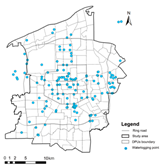 | .SHP | https://map.baidu.com/ | We supplemented our collection of waterlogging points by gathering information on recent reports of waterlogging, as well as collecting puddle points from Baidu Maps. |
| 4 | Building Density | Building Data (2021) | 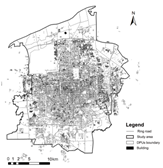 | .SHP | https://map.baidu.com/ | We calculated the building density for each unit by computing the ratio between the building area and the area of the DPUs. |
| 5 | Road Density | Road Data (2021) |  | .SHP | https://map.baidu.com/ | We computed the total length of road network within each DPU, and divided it by the spatial unit’s area to obtain the road network density |
| 6 | Park Accessibility | Park Entrance and Exit Data (2022) | 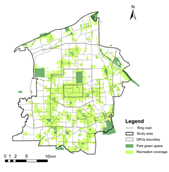 | .SHP | https://map.baidu.com/ | We obtained data on “Green space” and “Plaza” by using AOI on Baidu Maps, supplemented any missing park data through visual interpretation and conducted network analysis to calculate the accessibility of the parks. |
| 7 | Population Density | Population Data of DPUs (2022) | 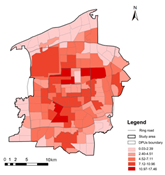 | .SHP | Non-public data from Xi’an Urban Planning and Design Institute | We calculated population density using population data and the area of DPUs, which were used for exposure assessment. |
| 8 | Proportion of Elderly | The Seventh Census Data(2020) | 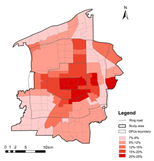 | .SHP | http://www.stats.gov.cn/english/PressRelease/202105/t20210510_1817185.html | / |
| 9 | Proportion of Children | The seventh Census Data(2020) | 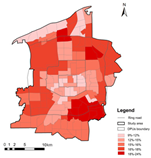 | .SHP | / | |
| 10 | Residential land area not covered by parks and green spaces within the service radius | Residential Land | 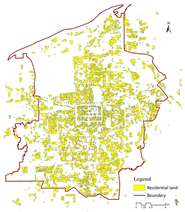 | .SHP | Non-public data from Xi’an Urban Planning and Design Institute | We overlaid the network analysis results with the residential areas in the central urban area of Xi’an and calculated the residential area not covered in each DPU. |
| 11 | Urban Green Infrastructure (UGI) | GF-1 (2017) | 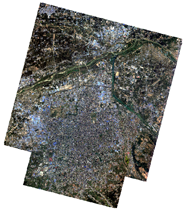 | .TIF/2m | http://www.gscloud.cn | The distribution data of green space in Xi’an city is based on the 2-m resolution high-resolution satellite imagery of GF-1 on April 12, 2017, covering the central urban area. |
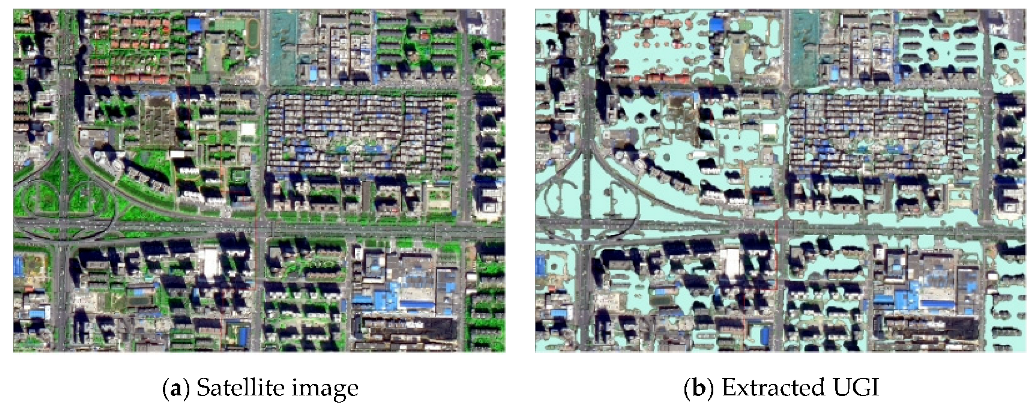
Appendix B. List of Experts Consulted for Opinions
| Occupation Type | Numbers of Experts | Professional Fields | Numbers of Experts |
|---|---|---|---|
| Government Administrator | 7 | Urban Planning | 3 |
| Ecological Planning | 2 | ||
| Environmental Management | 1 | ||
| Urban Greening | 1 | ||
| Urban Planner | 7 | Urban Planning | 2 |
| Urban Design | 2 | ||
| Landscape Planning | 2 | ||
| Ecological Planning | 1 | ||
| Academic Researcher | 11 | Urban Planning | 5 |
| Landscape Architecture | 4 | ||
| Ecological Planning | 2 |
| ID | Urgency, Compared to Synergy | Urgency, Compared to Feasibility | Synergy, Compared to Feasibility |
|---|---|---|---|
| 1 | 9.00 | 5.00 | 0.25 |
| 2 | 1.00 | 5.00 | 5.00 |
| 3 | 7.00 | 3.00 | 0.33 |
| 4 | 3.00 | 1.00 | 0.33 |
| 5 | 5.00 | 2.00 | 0.20 |
| 6 | 0.20 | 0.50 | 5.00 |
| 7 | 0.20 | 0.20 | 1.00 |
| 8 | 4.00 | 3.00 | 0.33 |
| 9 | 2.00 | 0.33 | 0.33 |
| 10 | 5.00 | 1.00 | 0.20 |
| 11 | 4.00 | 9.00 | 5.00 |
| 12 | 5.00 | 3.00 | 0.33 |
| 13 | 5.00 | 5.00 | 5.00 |
| 14 | 5.00 | 3.00 | 0.33 |
| 15 | 2.00 | 5.00 | 5.00 |
| 16 | 1.00 | 0.33 | 0.20 |
| 17 | 0.25 | 0.25 | 3.00 |
| Geometric Mean | 2.13 | 1.59 | 0.81 |
Appendix C. Detailed Result of the TOPSIS Method for All DPUs
| DPUs Code | Positive Ideal Distance | Negative Ideal Distance | Urgency | Feasibility | Synergy | Score | Ranking |
|---|---|---|---|---|---|---|---|
| LH-07 | 0.29 | 0.84 | 1.00 | 0.50 | 0.81 | 0.75 | 1 |
| LH-02 | 0.31 | 0.77 | 0.93 | 0.67 | 0.48 | 0.71 | 2 |
| DMG-01 | 0.34 | 0.76 | 0.94 | 0.50 | 0.58 | 0.69 | 3 |
| LH-04 | 0.37 | 0.75 | 0.70 | 1.00 | 0.37 | 0.67 | 4 |
| LH-14 | 0.38 | 0.74 | 0.85 | 0.33 | 0.87 | 0.66 | 5 |
| LH-08 | 0.36 | 0.70 | 0.82 | 0.67 | 0.40 | 0.66 | 6 |
| LH-09 | 0.35 | 0.67 | 0.74 | 0.67 | 0.49 | 0.66 | 7 |
| LH-03 | 0.39 | 0.73 | 0.90 | 0.67 | 0.30 | 0.65 | 8 |
| XC-01 | 0.40 | 0.70 | 0.84 | 0.33 | 0.72 | 0.63 | 9 |
| LH-05 | 0.40 | 0.69 | 0.82 | 0.67 | 0.30 | 0.63 | 10 |
| LH-06 | 0.40 | 0.66 | 0.82 | 0.50 | 0.45 | 0.63 | 11 |
| LH-12 | 0.54 | 0.79 | 0.91 | 0.00 | 1.00 | 0.59 | 12 |
| LH-01 | 0.47 | 0.68 | 0.82 | 0.67 | 0.14 | 0.59 | 13 |
| XC-06 | 0.53 | 0.71 | 0.67 | 1.00 | 0.00 | 0.57 | 14 |
| XC-02 | 0.51 | 0.64 | 0.84 | 0.17 | 0.55 | 0.56 | 15 |
| XC-08 | 0.56 | 0.68 | 0.59 | 1.00 | 0.00 | 0.55 | 16 |
| YT-08 | 0.54 | 0.65 | 0.78 | 0.67 | 0.00 | 0.55 | 17 |
| XC-07 | 0.56 | 0.66 | 0.54 | 1.00 | 0.02 | 0.54 | 18 |
| BQ-03 | 0.61 | 0.70 | 1.00 | 0.17 | 0.14 | 0.53 | 19 |
| BL-03 | 0.55 | 0.62 | 0.85 | 0.17 | 0.38 | 0.53 | 20 |
| WY-05 | 0.58 | 0.65 | 0.52 | 1.00 | 0.00 | 0.53 | 21 |
| XC-04 | 0.56 | 0.61 | 0.85 | 0.33 | 0.13 | 0.52 | 22 |
| LH-13 | 0.60 | 0.64 | 0.85 | 0.00 | 0.51 | 0.51 | 23 |
| XC-09 | 0.56 | 0.56 | 0.62 | 0.67 | 0.04 | 0.50 | 24 |
| BQ-01 | 0.61 | 0.61 | 0.84 | 0.33 | 0.00 | 0.50 | 25 |
| BQ-04 | 0.61 | 0.61 | 0.84 | 0.33 | 0.00 | 0.50 | 25 |
| YT-05 | 0.63 | 0.61 | 0.87 | 0.17 | 0.10 | 0.49 | 26 |
| BL-05 | 0.64 | 0.61 | 0.85 | 0.00 | 0.34 | 0.49 | 27 |
| DMG-04 | 0.66 | 0.62 | 0.89 | 0.17 | 0.00 | 0.48 | 28 |
| WY-13 | 0.64 | 0.59 | 0.83 | 0.00 | 0.32 | 0.48 | 29 |
| YT-04 | 0.62 | 0.56 | 0.77 | 0.33 | 0.00 | 0.47 | 30 |
| WY-08 | 0.69 | 0.62 | 0.89 | 0.00 | 0.13 | 0.47 | 31 |
| YT-06 | 0.67 | 0.59 | 0.85 | 0.00 | 0.20 | 0.47 | 32 |
| LH-11 | 0.69 | 0.58 | 0.84 | 0.00 | 0.15 | 0.46 | 33 |
| YT-10 | 0.63 | 0.54 | 0.73 | 0.33 | 0.00 | 0.46 | 34 |
| BL-09 | 0.69 | 0.58 | 0.84 | 0.00 | 0.14 | 0.46 | 35 |
| DMG-05 | 0.58 | 0.49 | 0.65 | 0.33 | 0.20 | 0.46 | 36 |
| DMG-03 | 0.69 | 0.57 | 0.82 | 0.00 | 0.14 | 0.45 | 37 |
| BL-06 | 0.65 | 0.53 | 0.72 | 0.00 | 0.37 | 0.45 | 38 |
| BL-01 | 0.67 | 0.54 | 0.77 | 0.00 | 0.24 | 0.45 | 39 |
| CB-10 | 0.61 | 0.49 | 0.59 | 0.50 | 0.02 | 0.44 | 40 |
| HT-01 | 0.62 | 0.49 | 0.58 | 0.50 | 0.00 | 0.44 | 41 |
| JK-10 | 0.64 | 0.50 | 0.67 | 0.33 | 0.00 | 0.44 | 42 |
| CB-13 | 0.64 | 0.48 | 0.46 | 0.67 | 0.00 | 0.43 | 43 |
| XC-05 | 0.63 | 0.47 | 0.62 | 0.33 | 0.07 | 0.43 | 44 |
| XC-03 | 0.61 | 0.45 | 0.59 | 0.33 | 0.16 | 0.42 | 45 |
| BL-04 | 0.63 | 0.45 | 0.59 | 0.33 | 0.11 | 0.42 | 46 |
| CB-15 | 0.66 | 0.45 | 0.39 | 0.67 | 0.00 | 0.41 | 47 |
| BL-02 | 0.72 | 0.49 | 0.70 | 0.00 | 0.10 | 0.40 | 48 |
| DMG-02 | 0.73 | 0.48 | 0.70 | 0.00 | 0.08 | 0.40 | 49 |
| YT-13 | 0.67 | 0.44 | 0.58 | 0.33 | 0.00 | 0.40 | 50 |
| JK-16 | 0.75 | 0.49 | 0.72 | 0.00 | 0.00 | 0.40 | 51 |
| BL-10 | 0.74 | 0.48 | 0.70 | 0.00 | 0.05 | 0.40 | 52 |
| LH-10 | 0.72 | 0.47 | 0.67 | 0.00 | 0.12 | 0.39 | 53 |
| CA-04 | 0.67 | 0.43 | 0.57 | 0.33 | 0.00 | 0.39 | 54 |
| CA-06 | 0.67 | 0.43 | 0.57 | 0.33 | 0.00 | 0.39 | 54 |
| QJ-02 | 0.66 | 0.43 | 0.48 | 0.50 | 0.00 | 0.39 | 55 |
| YT-07 | 0.66 | 0.42 | 0.46 | 0.50 | 0.02 | 0.39 | 56 |
| JK-15 | 0.76 | 0.47 | 0.67 | 0.00 | 0.00 | 0.38 | 57 |
| QJ-01 | 0.76 | 0.46 | 0.67 | 0.00 | 0.00 | 0.38 | 58 |
| BL-07 | 0.74 | 0.43 | 0.62 | 0.00 | 0.10 | 0.37 | 59 |
| YT-03 | 0.76 | 0.44 | 0.64 | 0.00 | 0.01 | 0.37 | 60 |
| WY-07 | 0.69 | 0.39 | 0.50 | 0.33 | 0.00 | 0.36 | 61 |
| YT-15 | 0.73 | 0.40 | 0.24 | 0.67 | 0.00 | 0.35 | 62 |
| CB-05 | 0.73 | 0.38 | 0.54 | 0.17 | 0.00 | 0.34 | 63 |
| YT-02 | 0.71 | 0.36 | 0.45 | 0.33 | 0.00 | 0.33 | 64 |
| QJ-06 | 0.78 | 0.39 | 0.57 | 0.00 | 0.00 | 0.33 | 65 |
| JK-14 | 0.79 | 0.38 | 0.55 | 0.00 | 0.00 | 0.33 | 66 |
| JK-11 | 0.79 | 0.38 | 0.55 | 0.00 | 0.00 | 0.33 | 66 |
| CB-06 | 0.74 | 0.36 | 0.50 | 0.17 | 0.00 | 0.33 | 67 |
| BL-08 | 0.74 | 0.35 | 0.49 | 0.17 | 0.03 | 0.32 | 68 |
| GX-16 | 0.79 | 0.37 | 0.53 | 0.00 | 0.00 | 0.32 | 69 |
| YT-01 | 0.80 | 0.37 | 0.10 | 0.67 | 0.00 | 0.31 | 70 |
| QJ-03 | 0.79 | 0.36 | 0.53 | 0.00 | 0.00 | 0.31 | 71 |
| GX-04 | 0.80 | 0.36 | 0.52 | 0.00 | 0.00 | 0.31 | 72 |
| WY-12 | 0.73 | 0.32 | 0.39 | 0.33 | 0.00 | 0.31 | 73 |
| YT-14 | 0.74 | 0.32 | 0.39 | 0.33 | 0.00 | 0.30 | 74 |
| WY-DYZ-01 | 0.75 | 0.32 | 0.26 | 0.50 | 0.00 | 0.30 | 75 |
| YT-09 | 0.85 | 0.36 | 0.01 | 0.67 | 0.00 | 0.30 | 76 |
| CA-03 | 0.81 | 0.33 | 0.48 | 0.00 | 0.00 | 0.29 | 77 |
| JK-13 | 0.81 | 0.33 | 0.48 | 0.00 | 0.00 | 0.29 | 78 |
| JK-09 | 0.81 | 0.33 | 0.48 | 0.00 | 0.00 | 0.29 | 78 |
| QJ-08 | 0.78 | 0.30 | 0.19 | 0.50 | 0.00 | 0.28 | 79 |
| CA-07 | 0.77 | 0.28 | 0.31 | 0.33 | 0.00 | 0.27 | 80 |
| YT-11 | 0.78 | 0.28 | 0.39 | 0.17 | 0.00 | 0.27 | 81 |
| CB-12 | 0.82 | 0.28 | 0.13 | 0.50 | 0.00 | 0.26 | 82 |
| JK-12 | 0.83 | 0.28 | 0.40 | 0.00 | 0.00 | 0.25 | 83 |
| QJ-04 | 0.83 | 0.28 | 0.40 | 0.00 | 0.00 | 0.25 | 84 |
| CB-11 | 0.79 | 0.25 | 0.26 | 0.33 | 0.00 | 0.24 | 85 |
| GX-15 | 0.84 | 0.27 | 0.39 | 0.00 | 0.00 | 0.24 | 86 |
| WY-06 | 0.81 | 0.24 | 0.33 | 0.17 | 0.00 | 0.23 | 87 |
| CA-05 | 0.84 | 0.25 | 0.37 | 0.00 | 0.00 | 0.23 | 88 |
| GX-08 | 0.85 | 0.25 | 0.36 | 0.00 | 0.00 | 0.22 | 89 |
| CB-14 | 0.86 | 0.23 | 0.34 | 0.00 | 0.00 | 0.21 | 90 |
| GX-03 | 0.86 | 0.23 | 0.33 | 0.00 | 0.00 | 0.21 | 91 |
| GX-07 | 0.86 | 0.23 | 0.33 | 0.00 | 0.00 | 0.21 | 91 |
| CA-02 | 0.86 | 0.23 | 0.33 | 0.00 | 0.00 | 0.21 | 92 |
| QJ-05 | 0.86 | 0.23 | 0.33 | 0.00 | 0.00 | 0.21 | 93 |
| QJ-DYZ-01 | 0.83 | 0.21 | 0.16 | 0.33 | 0.00 | 0.20 | 94 |
| WY-09 | 0.84 | 0.21 | 0.16 | 0.33 | 0.00 | 0.20 | 95 |
| BQ-02 | 0.83 | 0.20 | 0.26 | 0.17 | 0.00 | 0.19 | 96 |
| GX-02 | 0.87 | 0.20 | 0.30 | 0.00 | 0.00 | 0.19 | 97 |
| CB-16 | 0.86 | 0.19 | 0.10 | 0.33 | 0.00 | 0.18 | 98 |
| WY-04 | 0.86 | 0.19 | 0.10 | 0.33 | 0.00 | 0.18 | 98 |
| CB-02 | 0.84 | 0.19 | 0.24 | 0.17 | 0.00 | 0.18 | 99 |
| WY-03 | 0.87 | 0.19 | 0.09 | 0.33 | 0.00 | 0.18 | 100 |
| GX-10 | 0.89 | 0.18 | 0.26 | 0.00 | 0.00 | 0.17 | 101 |
| YT-12 | 0.89 | 0.18 | 0.26 | 0.00 | 0.00 | 0.17 | 101 |
| CB-17 | 0.91 | 0.18 | 0.00 | 0.33 | 0.00 | 0.16 | 102 |
| JK-06 | 0.91 | 0.18 | 0.00 | 0.33 | 0.00 | 0.16 | 102 |
| WY-10 | 0.91 | 0.18 | 0.00 | 0.33 | 0.00 | 0.16 | 102 |
| WY-01 | 0.91 | 0.18 | 0.00 | 0.33 | 0.00 | 0.16 | 102 |
| WY-02 | 0.91 | 0.18 | 0.00 | 0.33 | 0.00 | 0.16 | 102 |
| HT-02 | 0.89 | 0.16 | 0.24 | 0.00 | 0.00 | 0.16 | 103 |
| QJ-07 | 0.90 | 0.16 | 0.23 | 0.00 | 0.00 | 0.15 | 104 |
| DMG-DYZ-01 | 0.90 | 0.15 | 0.22 | 0.00 | 0.00 | 0.14 | 105 |
| JK-07 | 0.90 | 0.15 | 0.22 | 0.00 | 0.00 | 0.14 | 105 |
| JK-08 | 0.88 | 0.14 | 0.16 | 0.17 | 0.00 | 0.14 | 106 |
| YT-16 | 0.90 | 0.12 | 0.12 | 0.17 | 0.00 | 0.12 | 107 |
| WY-11 | 0.93 | 0.11 | 0.16 | 0.00 | 0.00 | 0.10 | 108 |
| CA-01 | 0.95 | 0.09 | 0.01 | 0.17 | 0.00 | 0.09 | 109 |
| GX-13 | 0.95 | 0.09 | 0.00 | 0.17 | 0.00 | 0.09 | 110 |
| HT-06 | 0.95 | 0.09 | 0.00 | 0.17 | 0.00 | 0.09 | 110 |
| JK-03 | 0.95 | 0.09 | 0.00 | 0.17 | 0.00 | 0.09 | 110 |
| GX-11 | 0.94 | 0.09 | 0.13 | 0.00 | 0.00 | 0.08 | 111 |
| GX-09 | 0.95 | 0.07 | 0.10 | 0.00 | 0.00 | 0.07 | 112 |
| CB-09 | 0.95 | 0.07 | 0.10 | 0.00 | 0.00 | 0.07 | 113 |
| JK-TX-01 | 1.00 | 0.01 | 0.01 | 0.00 | 0.00 | 0.01 | 114 |
| GX-14 | 1.00 | 0.01 | 0.01 | 0.00 | 0.00 | 0.01 | 115 |
| GX-12 | 1.00 | 0.01 | 0.01 | 0.00 | 0.00 | 0.01 | 115 |
| JK-04 | 1.00 | 0.01 | 0.01 | 0.00 | 0.00 | 0.01 | 115 |
| JK-05 | 1.00 | 0.01 | 0.01 | 0.00 | 0.00 | 0.01 | 115 |
| JK-02 | 1.00 | 0.01 | 0.01 | 0.00 | 0.00 | 0.01 | 115 |
| JK-01 | 1.00 | 0.01 | 0.01 | 0.00 | 0.00 | 0.01 | 115 |
| CB-07 | 1.00 | 0.00 | 0.00 | 0.00 | 0.00 | 0.00 | 116 |
| CB-08 | 1.00 | 0.00 | 0.00 | 0.00 | 0.00 | 0.00 | 116 |
| CB-04 | 1.00 | 0.00 | 0.00 | 0.00 | 0.00 | 0.00 | 116 |
| CB-03 | 1.00 | 0.00 | 0.00 | 0.00 | 0.00 | 0.00 | 116 |
| CB-01 | 1.00 | 0.00 | 0.00 | 0.00 | 0.00 | 0.00 | 116 |
| GX-01 | 1.00 | 0.00 | 0.00 | 0.00 | 0.00 | 0.00 | 116 |
| GX-06 | 1.00 | 0.00 | 0.00 | 0.00 | 0.00 | 0.00 | 116 |
| GX-05 | 1.00 | 0.00 | 0.00 | 0.00 | 0.00 | 0.00 | 116 |
| HT-05 | 1.00 | 0.00 | 0.00 | 0.00 | 0.00 | 0.00 | 116 |
| HT-04 | 1.00 | 0.00 | 0.00 | 0.00 | 0.00 | 0.00 | 116 |
| HT-03 | 1.00 | 0.00 | 0.00 | 0.00 | 0.00 | 0.00 | 116 |
References
- UN Department of Economic and Social Affairs. 2018 Revision of World Urbanization Prospects. Available online: https://www.un.org/en/desa/2018-revision-world-urbanization-prospects (accessed on 4 April 2023).
- Langemeyer, J.; Wedgwood, D.; McPhearson, T.; Baró, F.; Madsen, A.L.; Barton, D.N. Creating urban green infrastructure where it is needed—A spatial ecosystem service-based decision analysis of green roofs in Barcelona. Sci. Total. Environ. 2020, 707, 135487. [Google Scholar] [CrossRef]
- Wang, Y.-C.; Shen, J.-K.; Xiang, W.-N. Ecosystem service of green infrastructure for adaptation to urban growth: Function and configuration. Ecosyst. Health Sustain. 2018, 4, 132–143. [Google Scholar] [CrossRef]
- Larondelle, N.; Lauf, S. Balancing demand and supply of multiple urban ecosystem services on different spatial scales. Ecosyst. Serv. 2016, 22, 18–31. [Google Scholar] [CrossRef]
- Langemeyer, J.; Connolly, J.J. Weaving notions of justice into urban ecosystem services research and practice. Environ. Sci. Policy 2020, 109, 1–14. [Google Scholar] [CrossRef]
- Selmi, W.; Selmi, S.; Teller, J.; Weber, C.; Rivière, E.; Nowak, D.J. Prioritizing the provision of urban ecosystem services in deprived areas, a question of environmental justice. AMBIO 2021, 50, 1035–1046. [Google Scholar] [CrossRef]
- Tan, P.Y.; Zhang, J.; Masoudi, M.; Alemu, J.B.; Edwards, P.J.; Grêt-Regamey, A.; Richards, D.R.; Saunders, J.; Song, X.P.; Wong, L.W. A conceptual framework to untangle the concept of urban ecosystem services. Landsc. Urban Plan. 2020, 200, 103837. [Google Scholar] [CrossRef]
- Baker, F.; Smith, G.R.; Marsden, S.J.; Cavan, G. Mapping regulating ecosystem service deprivation in urban areas: A transferable high-spatial resolution uncertainty aware approach. Ecol. Indic. 2021, 121, 107058. [Google Scholar] [CrossRef]
- Andersson, E.; Barthel, S.; Borgström, S.; Colding, J.; Elmqvist, T.; Folke, C.; Gren, Å. Reconnecting Cities to the Biosphere: Stewardship of Green Infrastructure and Urban Ecosystem Services. AMBIO 2014, 43, 445–453. [Google Scholar] [CrossRef]
- Haase, D.; Larondelle, N.; Andersson, E.; Artmann, M.; Borgström, S.; Breuste, J.; Gomez-Baggethun, E.; Gren, Å.; Hamstead, Z.; Hansen, R.; et al. A Quantitative Review of Urban Ecosystem Service Assessments: Concepts, Models, and Implementation. Ambio 2014, 43, 413–433. [Google Scholar] [CrossRef]
- Elliott, R.M.; Motzny, A.E.; Majd, S.; Chavez, F.J.V.; Laimer, D.; Orlove, B.S.; Culligan, P.J. Identifying linkages between urban green infrastructure and ecosystem services using an expert opinion methodology. AMBIO 2020, 49, 569–583. [Google Scholar] [CrossRef]
- Cortinovis, C.; Geneletti, D. A framework to explore the effects of urban planning decisions on regulating ecosystem services in cities. Ecosyst. Serv. 2019, 38, 100946. [Google Scholar] [CrossRef]
- Zhai, J.; Ren, J.; Xi, M.; Tang, X.; Zhang, Y. Multiscale watershed landscape infrastructure: Integrated system design for sponge city development. Urban For. Urban Green. 2021, 60, 127060. [Google Scholar] [CrossRef]
- Chang, C.-R.; Li, M.-H. Effects of urban parks on the local urban thermal environment. Urban For. Urban Green. 2014, 13, 672–681. [Google Scholar] [CrossRef]
- Wu, J.; Jin, X.; Wang, H.; Feng, Z. Evaluating the supply-demand balance of cultural ecosystem services with budget expectation in Shenzhen, China. Ecol. Indic. 2022, 142, 109165. [Google Scholar] [CrossRef]
- Gómez-Baggethun, E.; Barton, D.N. Classifying and valuing ecosystem services for urban planning. Ecol. Econ. 2013, 86, 235–245. [Google Scholar] [CrossRef]
- Kremer, P.; Hamstead, Z.A.; McPhearson, T. The value of urban ecosystem services in New York City: A spatially explicit multicriteria analysis of landscape scale valuation scenarios. Environ. Sci. Policy 2016, 62, 57–68. [Google Scholar] [CrossRef]
- Jalkanen, J.; Vierikko, K.; Moilanen, A. Spatial prioritization for urban Biodiversity Quality using biotope maps and expert opinion. Urban For. Urban Green. 2020, 49, 126586. [Google Scholar] [CrossRef]
- Wang, Y.; Chang, Q.; Fan, P. A framework to integrate multifunctionality analyses into green infrastructure planning. Landsc. Ecol. 2021, 36, 1951–1969. [Google Scholar] [CrossRef]
- Geneletti, D. Combining stakeholder analysis and spatial multicriteria evaluation to select and rank inert landfill sites. Waste Manag. 2010, 30, 328–337. [Google Scholar] [CrossRef]
- Tran, T.J.; Helmus, M.R.; Behm, J.E. Green infrastructure space and traits (GIST) model: Integrating green infrastructure spatial placement and plant traits to maximize multifunctionality. Urban For. Urban Green. 2020, 49, 126635. [Google Scholar] [CrossRef]
- Goodspeed, R.; Liu, R.; Gounaridis, D.; Lizundia, C.; Newell, J. A regional spatial planning model for multifunctional green infrastructure. Environ. Plan. B Urban Anal. City Sci. 2022, 49, 815–833. [Google Scholar] [CrossRef]
- Cortinovis, C.; Geneletti, D. A performance-based planning approach integrating supply and demand of urban ecosystem services. Landsc. Urban Plan. 2020, 201, 103842. [Google Scholar] [CrossRef]
- Karayalcin, I.I. The Analytic Hierarchy Process: Planning, Priority Setting, Resource Allocation; Saaty, T.L., Ed.; McGraw-Hill: New York, NY, USA, 1980; ISBN 0377-2217. [Google Scholar]
- Meerow, S.; Newell, J.P. Spatial planning for multifunctional green infrastructure: Growing resilience in Detroit. Landsc. Urban Plan. 2017, 159, 62–75. [Google Scholar] [CrossRef]
- Venter, Z.S.; Barton, D.N.; Martinez-Izquierdo, L.; Langemeyer, J.; Baró, F.; McPhearson, T. Interactive spatial planning of urban green infrastructure—Retrofitting green roofs where ecosystem services are most needed in Oslo. Ecosyst. Serv. 2021, 50, 101314. [Google Scholar] [CrossRef]
- Sanon, S.; Hein, T.; Douven, W.; Winkler, P. Quantifying ecosystem service trade-offs: The case of an urban floodplain in Vienna, Austria. J. Environ. Manag. 2012, 111, 159–172. [Google Scholar] [CrossRef]
- Wisner, B. At Risk: Natural Hazards, People’s Vulnerability and Disasters; Psychology Press: London, UK, 2004; ISBN 0-415-25215-6. [Google Scholar]
- Tieskens, K.F.; Smith, I.A.; Jimenez, R.B.; Hutyra, L.R.; Fabian, M.P. Mapping the gaps between cooling benefits of urban greenspace and population heat vulnerability. Sci. Total. Environ. 2022, 845, 157283. [Google Scholar] [CrossRef]
- Norton, B.A.; Coutts, A.M.; Livesley, S.J.; Harris, R.J.; Hunter, A.M.; Williams, N.S.G. Planning for cooler cities: A framework to prioritise green infrastructure to mitigate high temperatures in urban landscapes. Landsc. Urban Plan. 2015, 134, 127–138. [Google Scholar] [CrossRef]
- Xin, R.; Zeng, J.; Li, K.; Wang, Q.; Ding, S. Identify Key Areas and Priority Levels of Urban Waterlogging Regulation Service Supply and Demand. Acta Ecol. Sin. 2022, 42, 500–512. [Google Scholar]
- Wu, X.; Tan, C. Evaluation of Ecosystem Services Excess Demand in the Central Area of Wuhan: A Discussion Based on Mismatches between Supply and Demand of Green Infrastructure. Chin. Landsc. Archit. 2020, 36, 127–132. [Google Scholar] [CrossRef]
- Haines-Young, R.; Potschin, M. The Links between Biodiversity, Ecosystem Services and Human Well-Being. In Ecosystem Ecology: A New Synthesis; Cambridge University Press: Cambridge, UK, 2012; pp. 110–139. [Google Scholar] [CrossRef]
- De Manuel, B.F.; Méndez-Fernández, L.; Peña, L.; Ametzaga-Arregi, I. A new indicator of the effectiveness of urban green infrastructure based on ecosystem services assessment. Basic Appl. Ecol. 2021, 53, 12–25. [Google Scholar] [CrossRef]
- Parsa, V.A.; Salehi, E.; Yavari, A.R.; van Bodegom, P.M. An improved method for assessing mismatches between supply and demand in urban regulating ecosystem services: A case study in Tabriz, Iran. PLoS ONE 2019, 14, e0220750. [Google Scholar] [CrossRef]
- Burkhard, B.; Kroll, F.; Nedkov, S.; Müller, F. Mapping ecosystem service supply, demand and budgets. Ecol. Indic. 2012, 21, 17–29. [Google Scholar] [CrossRef]
- Shen, J.; Chen, C.; Wang, Y. What are the appropriate mapping units for ecosystem service assessments? A systematic review. Ecosyst. Health Sustain. 2021, 7, 1888655. [Google Scholar] [CrossRef]
- Zhou, C.; Wu, Y. A Planning Support Tool for Layout Integral Optimization of Urban Blue–Green Infrastructure. Sustainability 2020, 12, 1613. [Google Scholar] [CrossRef]
- Mao, Q.; Huang, G.; Wu, J. Urban Ecosystem Services: A Review. Chin. J. Appl. Ecol. 2015, 26, 1023–1033. [Google Scholar] [CrossRef]
- Lin, Y.; Chen, X.; Huang, L.; Zhu, C.; Shahtahmassebi, A.; Zhang, J.; Shen, S.; Peng, R.; Deng, J.; Wang, K.; et al. Fine-scale mapping of urban ecosystem service demand in a metropolitan context: A population-income-environmental perspective. Sci. Total. Environ. 2021, 781, 146784. [Google Scholar] [CrossRef]
- Li, F.; Guo, S.; Li, D.; Li, X.; Li, J.; Xie, S. A multi-criteria spatial approach for mapping urban ecosystem services demand. Ecol. Indic. 2020, 112, 106119. [Google Scholar] [CrossRef]
- Baró, F.; Haase, D.; Gómez-Baggethun, E.; Frantzeskaki, N. Mismatches between ecosystem services supply and demand in urban areas: A quantitative assessment in five European cities. Ecol. Indic. 2015, 55, 146–158. [Google Scholar] [CrossRef]
- Villamagna, A.M.; Angermeier, P.L.; Bennett, E.M. Capacity, pressure, demand, and flow: A conceptual framework for analyzing ecosystem service provision and delivery. Ecol. Complex. 2013, 15, 114–121. [Google Scholar] [CrossRef]
- Liu, Y.; Zhou, Y. Territory spatial planning and national governance system in China. Land Use Policy 2021, 102, 105288. [Google Scholar] [CrossRef]
- Chen, H.; Wang, N.; Liu, Y.; Zhang, Y.; Lu, Y.; Li, X.; Chen, C.; Liu, Y. A green infrastructure planning framework–guidance for priority, hubs and types. Urban For. Urban Green. 2022, 70, 127545. [Google Scholar] [CrossRef]
- Shen, J.; Guo, X.; Wang, Y. Identifying and setting the natural spaces priority based on the multi-ecosystem services capacity index. Ecol. Indic. 2021, 125, 107473. [Google Scholar] [CrossRef]
- Dong, X.; Ye, Y.; Yang, R.; Li, X. Planning for green infrastructure based on integration of multi-driving factors: A case study in pilot site of sponge city. Sustain. Cities Soc. 2023, 93, 104549. [Google Scholar] [CrossRef]
- Chang, H.-S.; Lin, Z.-H.; Hsu, Y.-Y. Planning for green infrastructure and mapping synergies and trade-offs: A case study in the Yanshuei River Basin, Taiwan. Urban For. Urban Green. 2021, 65, 127325. [Google Scholar] [CrossRef]
- Chao, X.; Nan, M.; Fei, L.; Xiaoming, L.; Zhiyun, O. Research on Urban Green Infrastructure Management in Macao from the Perspective of Ecosystem Service Demand. Chin. Landsc. Archit. 2020, 36, 127–132. [Google Scholar]
- Ge, Y.; Han, L.; Zhao, Y.; Ao, Y.; Ding, J.; Zhu, Y.; Liu, B. Spatiotemporal Analysis of Urban Expansion in Xi’an from 1984 to 2016. Chin. J. Ecol. 2019, 38, 1491–1499. [Google Scholar] [CrossRef]
- Crichton, D. What can cities do to increase resilience? Philos. Trans. A Math. Phys. Eng. Sci. 2007, 365, 2731–2739. [Google Scholar] [CrossRef]
- Data of the Seventh National Population Census. Available online: http://www.stats.gov.cn/english/PressRelease/202105/t20210510_1817185.html (accessed on 12 September 2022).
- Ministry of Ecology and Environment of the People’s Republic of China. Technical Regulation for Ambient Air Quality Assessment (on Trial); Ministry of Ecology and Environment of the People’s Republic of China: Beijing, China, 2013; HJ 663-2013.
- Wang, G.; Jiao, J.; Bao, Y. Technical Guidelines for Urban Ecological Construction Environmental Performance Evaluation; China Architecture & Building Press: Beijing, China, 2015; pp. 52–53. ISBN 978-7-112-19354-7. [Google Scholar]
- Liu, Y.; Zhang, S.; Cheng, P.; Chen, P.; Wei, L.; Fang, X. Research and Application of Heat and Venti-lation Environment Assessment for City Planning—A Case Study of Jinan Central Urban Area. Ecol. Environ. Sci. 2017, 26, 1892–1903. [Google Scholar] [CrossRef]
- Jiménez-Muñoz, J.C.; Sobrino, J.A.; Skoković, D.; Mattar, C.; Cristóbal, J. Land Surface Temperature Retrieval Methods From Landsat-8 Thermal Infrared Sensor Data. IEEE Geosci. Remote Sens. Lett. 2014, 11, 1840–1843. [Google Scholar] [CrossRef]
- Notice on Carrying out the 2022 Urban Physical Examination by the Ministry of Housing and Urban-Rural Development. Available online: http://www.gov.cn/zhengce/zhengceku/2022-07/09/content_5700178.htm (accessed on 25 August 2022). (In Chinese)
- GB/T 51346-2019; Standard for Planning of Urban Green Space. National Standards of the People’s Republic of China: Beijing, China, 2019.
- Talen, E. The social equity of urban service distribution: An exploration of park access in pueblo, colorado, and macon, georgia. Urban Geogr. 1997, 18, 521–541. [Google Scholar] [CrossRef]
- Hansen, R.; Pauleit, S. From Multifunctionality to Multiple Ecosystem Services? A Conceptual Framework for Multifunctionality in Green Infrastructure Planning for Urban Areas. AMBIO 2014, 43, 516–529. [Google Scholar] [CrossRef]
- Davies, C.; MacFarlane, R.; McGloin, C.; Roe, M. Green Infrastructure Planning Guide. Project: Final Report; NECF, Annfield Plain: Durham, UK, 2006; pp. 145–151. [Google Scholar]
- Foroozesh, F.; Monavari, S.M.; Salmanmahiny, A.; Robati, M.; Rahimi, R. Assessment of sustainable urban development based on a hybrid decision-making approach: Group fuzzy BWM, AHP, and TOPSIS–GIS. Sustain. Cities Soc. 2021, 76, 103402. [Google Scholar] [CrossRef]
- Ramya, S.; Devadas, V. Integration of GIS, AHP and TOPSIS in evaluating suitable locations for industrial development: A case of Tehri Garhwal district, Uttarakhand, India. J. Clean. Prod. 2019, 238, 117872. [Google Scholar] [CrossRef]
- Sargaonkar, A.P.; Gupta, A.; Devotta, S. Dynamic weighting system for water quality index. Water Sci. Technol. 2008, 58, 1261–1271. [Google Scholar] [CrossRef]
- Ring, Z.; Damyanovic, D.; Reinwald, F. Green and Open Space Factor Vienna: A Steering and Evaluation Tool for Urban Green Infrastructure. Urban For. Urban Green. 2021, 62, 127131. [Google Scholar] [CrossRef]
- Charoenkit, S.; Piyathamrongchai, K. A review of urban green spaces multifunctionality assessment: A way forward for a standardized assessment and comparability. Ecol. Indic. 2019, 107, 105592. [Google Scholar] [CrossRef]
- De Valck, J.; Beames, A.; Liekens, I.; Bettens, M.; Seuntjens, P.; Broekx, S. Valuing urban ecosystem services in sustainable brownfield redevelopment. Ecosyst. Serv. 2019, 35, 139–149. [Google Scholar] [CrossRef]
- Mulligan, J.; Bukachi, V.; Clause, J.C.; Jewell, R.; Kirimi, F.; Odbert, C. Hybrid infrastructures, hybrid governance: New evidence from Nairobi (Kenya) on green-blue-grey infrastructure in informal settlements. Anthropocene 2020, 29, 100227. [Google Scholar] [CrossRef]
- Yang, X.; Huang, Z.; Ma, J.; Li, S.; Fu, F. Approaches to Public Participation in Urban Green Space Construction under the Refined Scale-A Case Study of “Tree Planting Plan” in Berlin and London. Chin. Landsc. Archit. 2022, 38, 109–114. [Google Scholar] [CrossRef]
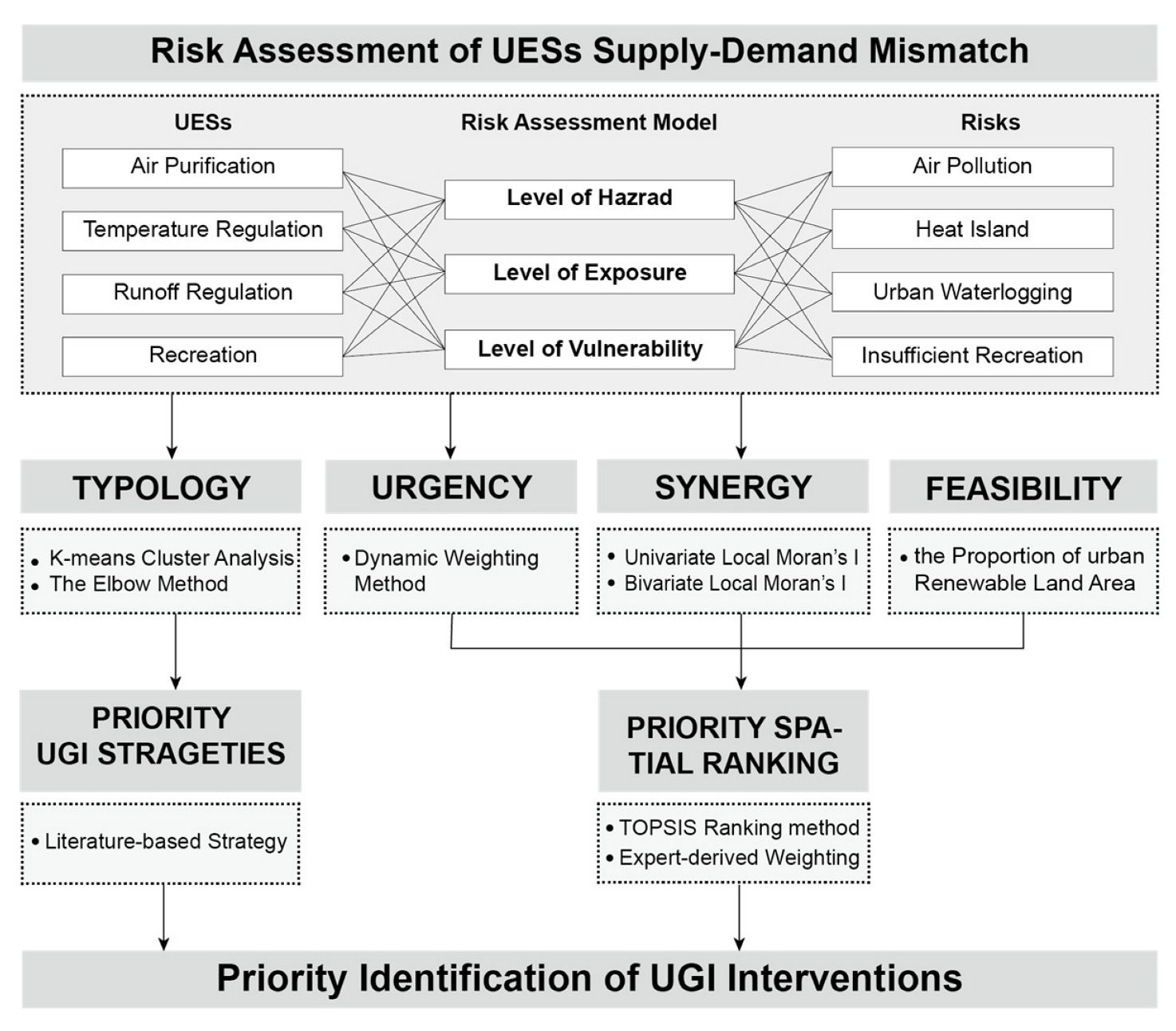
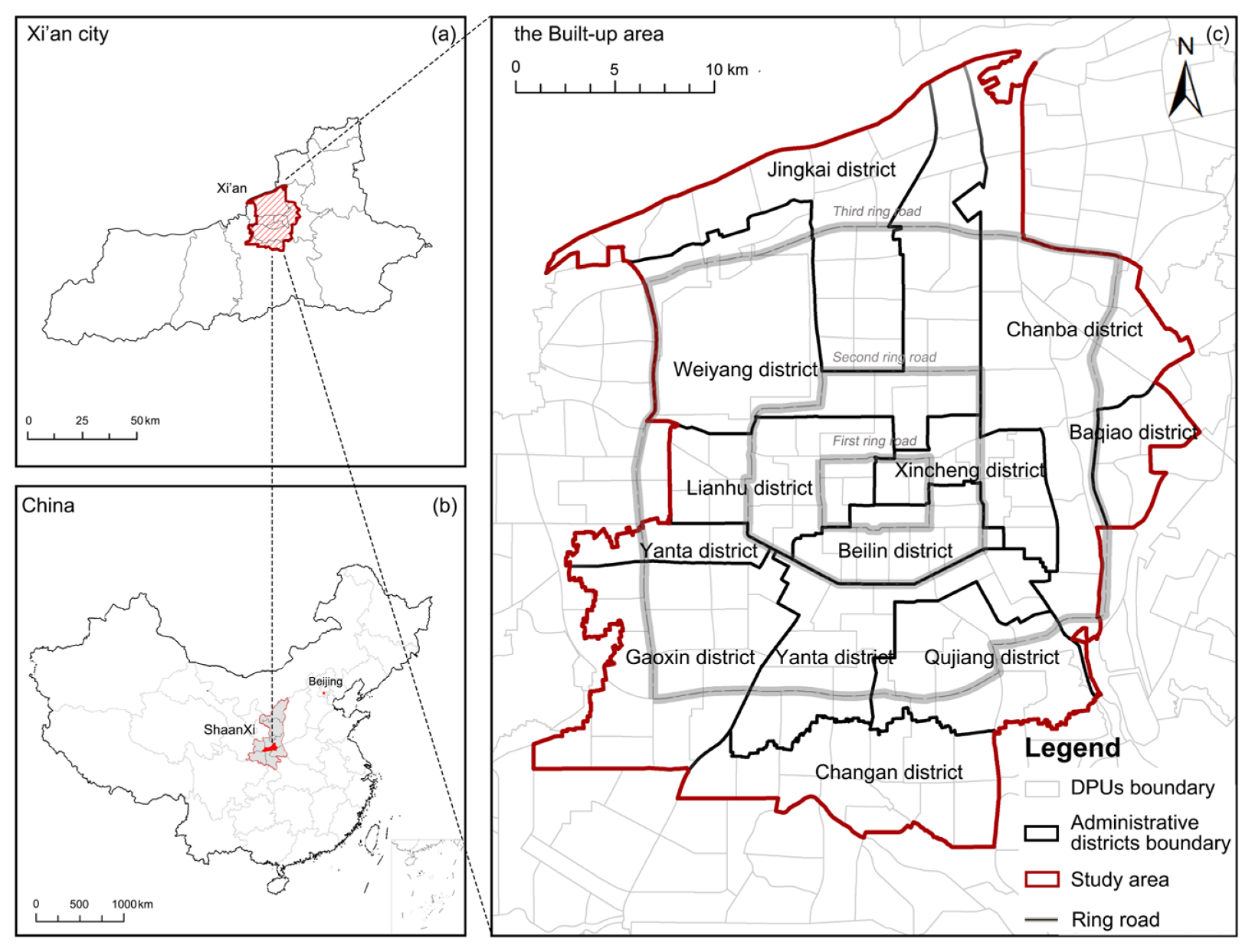


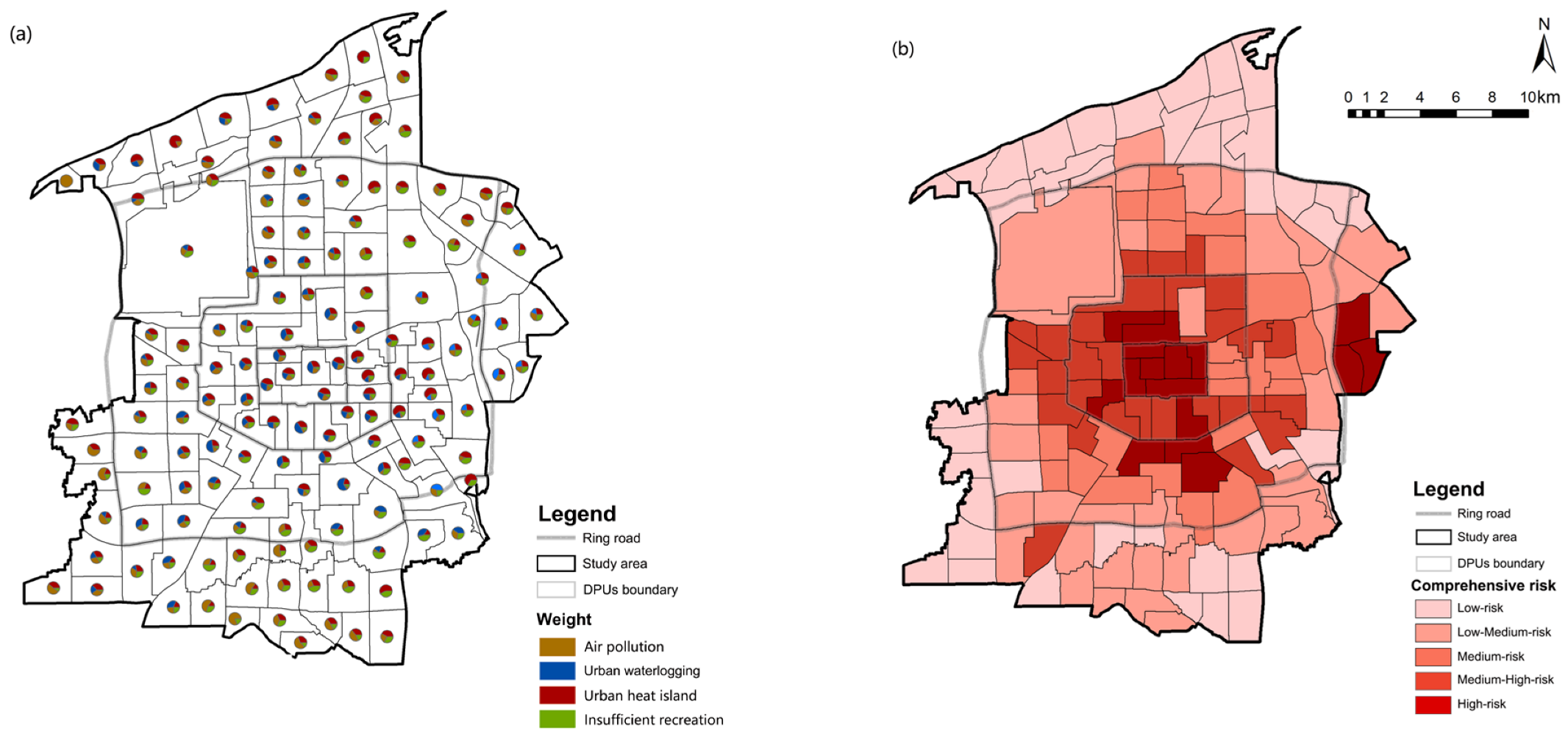
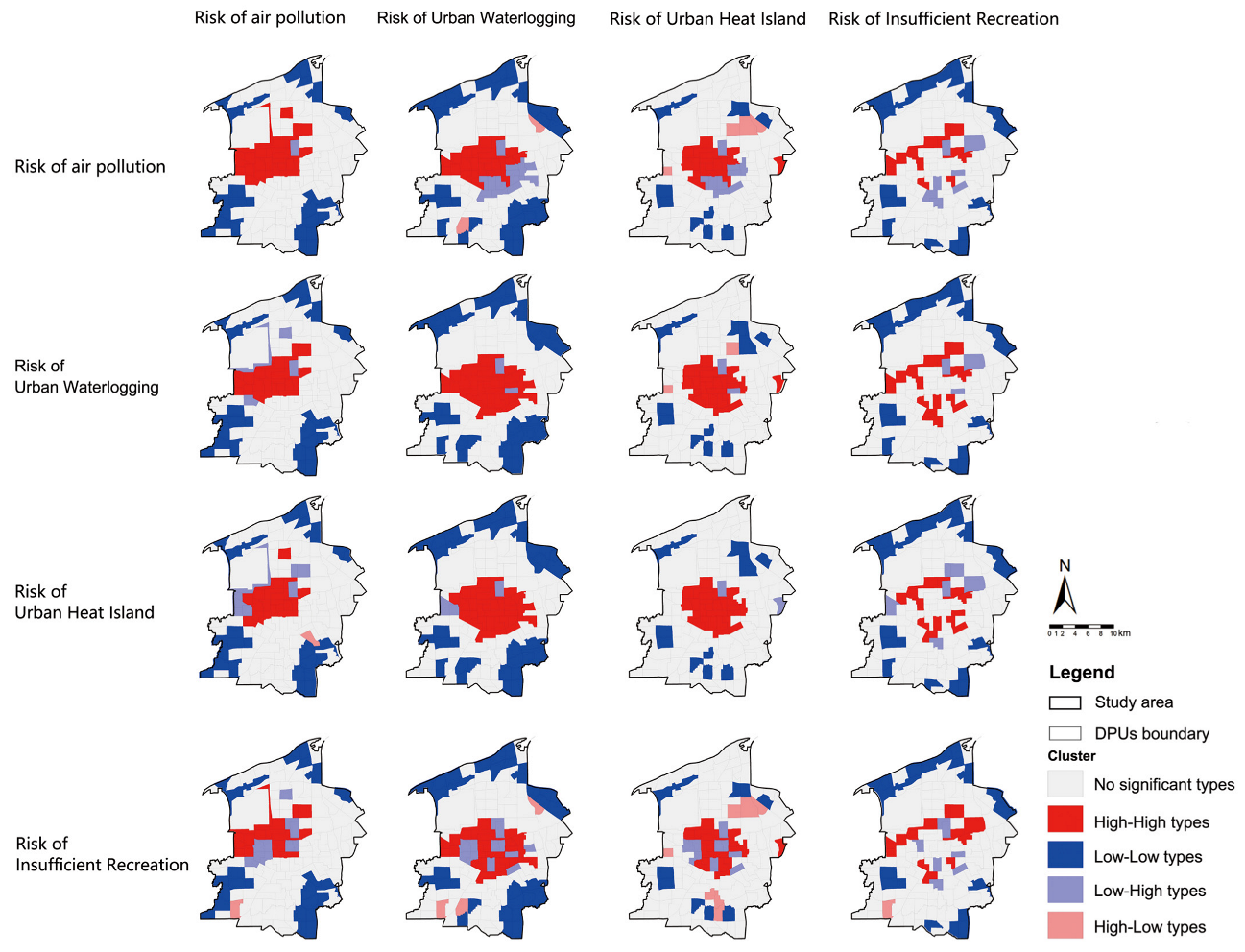



| UES | Risk | Indicator | Secondary Indicators | Threshold | Data Sources |
|---|---|---|---|---|---|
| Regulating Services | Air Pollution | H | Average Annual AQI Concentration | SO2: ≤60 μg/m3 | Xi’an Environmental Quality Monitoring Stations Daily Data (2020) (http://www.cnemc.cn/en/, accessed on 14 July 2021) |
| NO2: ≤150 μg/m3 | |||||
| PM10: ≤70 μg/m3 | |||||
| PM2.5: ≤35 μg/m3 | |||||
| E | Population Density | — | Population Data of DPUs (2022) * | ||
| V | Social Vulnerability | — | The Seventh Census Data, Proportion of Elderly and Children (2020) [52] | ||
| Urban Heat Island | H | Urban Heat Island Proportion Index (UHPI) | 0.1 | Landsat8 Remote Sensing Image (2019) (http://www.gscloud.cn, accessed on 3 August 2021) | |
| E | Population Density | — | Population Data of DPUs (2022) * | ||
| V | Social Vulnerability | — | The Seventh Census Data, Proportion of Elderly and Children (2020) [52] | ||
| Urban Waterlogging | H | The Density of Waterlogging Points | >0 | Waterlogging Point Data (2021) (https://map.baidu.com/, accessed on 28 August 2022) | |
| E | Population Density | — | Population Data of DPUs (2022) * | ||
| Building Density | — | Building Data (2021) (https://map.baidu.com/, accessed on 28 April 2022) | |||
| Road Density | — | Road Data (2021) (https://map.baidu.com/, accessed on 28 April 2022) | |||
| V | Social Vulnerability | — | The Seventh Census Data, Proportion of Elderly and Children (2020) [52] | ||
| Cultural Service | Insufficient Recreation | H | Residential land area not covered by parks and green spaces within the service radius | <1 ha, 300 m | Park Entrance and Exit Data (2022) (https://map.baidu.com/, accessed on 12 September 2021) Road Data (2021) (https://map.baidu.com/, accessed on 28 April 2022) Third National Land Survey Data, Residential Land (2021) * |
| 1–5 ha, 500 m | |||||
| >5 ha, 1000 m | |||||
| E | Population Density | — | Population Data of DPUs (2022) * | ||
| V | Social Vulnerability | — | The Seventh Census Data, Proportion of Elderly and Children (2020) [52] |
| Level | SUHI (°C) | Description |
|---|---|---|
| 1 | ≤−7.0 | Strong cold island |
| 2 | −7.0–−5.0 | Moderate cold island |
| 3 | −5.0–3.0 | Weak cold island |
| 4 | −3.0–3.0 | No heat island |
| 5 | 3.0–5.0 | Weak heat island |
| 6 | 5.0–7.0 | Moderate heat island |
| 7 | >7.0 | Strong heat island |
| Level | UHPI | Heat Island Level | Stress Level |
|---|---|---|---|
| 1 | 0–0.1 | None | 0 |
| 2 | 0.1–0.3 | Slight | 1 |
| 3 | 0.3–0.5 | Moderate | 2 |
| 4 | 0.5–0.7 | Severe | 3 |
| 5 | 0.7–0.9 | Extremely severe | 4 |
| 6 | 0.9–1 | Very extremely severe | 5 |
| Variable | Heat Island | Urban Waterlogging | Air Pollution | Insufficient Recreation | ||||
|---|---|---|---|---|---|---|---|---|
| Moran’s I | p Value | Moran’s I | p Value | Moran’s I | p Value | Moran’s I | p Value | |
| Heat Island | 0.724 ** | 0.001 | 0.631 ** | 0.001 | 0.427 ** | 0.001 | 0.401 ** | 0.001 |
| Urban Waterlogging | 0.626 ** | 0.001 | 0.699 ** | 0.001 | 0.421 ** | 0.001 | 0.367 ** | 0.001 |
| Air Pollution | 0.429 ** | 0.001 | 0.434 ** | 0.001 | 0.679 ** | 0.001 | 0.354 ** | 0.001 |
| Insufficient Recreation | 0.432 ** | 0.001 | 0.396 ** | 0.001 | 0.375 ** | 0.001 | 0.414 ** | 0.001 |
| Code | R | U | S | F | TS | Code | R | U | S | F | TS |
|---|---|---|---|---|---|---|---|---|---|---|---|
| LH-07 | 1 | 1.00 | 0.81 | 0.50 | 0.75 | YT-08 | 16 | 0.78 | 0.00 | 0.67 | 0.55 |
| LH-02 | 2 | 0.93 | 0.48 | 0.67 | 0.71 | XC-08 | 17 | 0.59 | 0.00 | 1.00 | 0.55 |
| DMG-01 | 3 | 0.94 | 0.58 | 0.50 | 0.69 | XC-07 | 18 | 0.54 | 0.02 | 1.00 | 0.54 |
| LH-04 | 4 | 0.70 | 0.37 | 1.00 | 0.67 | WY-05 | 19 | 0.52 | 0.00 | 1.00 | 0.53 |
| LH-09 | 5 | 0.74 | 0.49 | 0.67 | 0.66 | BL-03 | 20 | 0.85 | 0.38 | 0.17 | 0.53 |
| LH-08 | 6 | 0.82 | 0.40 | 0.67 | 0.66 | BQ-03 | 21 | 1.00 | 0.14 | 0.17 | 0.53 |
| LH-14 | 7 | 0.85 | 0.87 | 0.33 | 0.66 | XC-04 | 22 | 0.85 | 0.13 | 0.33 | 0.52 |
| LH-03 | 8 | 0.90 | 0.30 | 0.67 | 0.65 | LH-13 | 23 | 0.85 | 0.51 | 0.00 | 0.51 |
| LH-06 | 9 | 0.82 | 0.45 | 0.50 | 0.63 | BQ-04 | 24 | 0.84 | 0.00 | 0.33 | 0.50 |
| LH-05 | 10 | 0.82 | 0.30 | 0.67 | 0.63 | BQ-01 | 25 | 0.84 | 0.00 | 0.33 | 0.50 |
| XC-01 | 11 | 0.84 | 0.72 | 0.33 | 0.63 | XC-09 | 26 | 0.62 | 0.04 | 0.67 | 0.50 |
| LH-01 | 12 | 0.82 | 0.14 | 0.67 | 0.59 | BL-05 | 27 | 0.85 | 0.34 | 0.00 | 0.49 |
| LH-12 | 13 | 0.91 | 1.00 | 0.00 | 0.59 | YT-05 | 28 | 0.87 | 0.10 | 0.17 | 0.49 |
| XC-06 | 14 | 0.67 | 0.00 | 1.00 | 0.57 | WY-13 | 29 | 0.83 | 0.32 | 0.00 | 0.48 |
| XC-02 | 15 | 0.84 | 0.55 | 0.17 | 0.56 | DMG-04 | 30 | 0.89 | 0.00 | 0.17 | 0.48 |
Disclaimer/Publisher’s Note: The statements, opinions and data contained in all publications are solely those of the individual author(s) and contributor(s) and not of MDPI and/or the editor(s). MDPI and/or the editor(s) disclaim responsibility for any injury to people or property resulting from any ideas, methods, instructions or products referred to in the content. |
© 2023 by the authors. Licensee MDPI, Basel, Switzerland. This article is an open access article distributed under the terms and conditions of the Creative Commons Attribution (CC BY) license (https://creativecommons.org/licenses/by/4.0/).
Share and Cite
Wang, D.; Dai, R.; Luo, Z.; Wang, Y. Urgency, Feasibility, Synergy, and Typology: A Framework for Identifying Priority of Urban Green Infrastructure Intervention in Sustainable Urban Renewal. Sustainability 2023, 15, 10217. https://doi.org/10.3390/su151310217
Wang D, Dai R, Luo Z, Wang Y. Urgency, Feasibility, Synergy, and Typology: A Framework for Identifying Priority of Urban Green Infrastructure Intervention in Sustainable Urban Renewal. Sustainability. 2023; 15(13):10217. https://doi.org/10.3390/su151310217
Chicago/Turabian StyleWang, Dingran, Rengqi Dai, Zihan Luo, and Yuhui Wang. 2023. "Urgency, Feasibility, Synergy, and Typology: A Framework for Identifying Priority of Urban Green Infrastructure Intervention in Sustainable Urban Renewal" Sustainability 15, no. 13: 10217. https://doi.org/10.3390/su151310217





